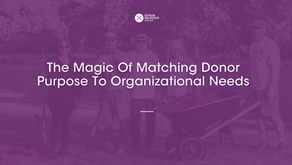The One Donor Relations Strategy You Need to Implement Right Now
- Lynne Wester

- Apr 6, 2022
- 2 min read
There is a shift happening in donor relations, and we're here for it! In fact, we've been championing this approach for a few years now. We've helped dozens of shops implement this strategy, and the results are profound — happier donors, better retention, record-breaking fundraising years — this stuff really works! Do we have your attention?
If you’ve attended a recent DRG webinar or conference, you’ve heard us talk about this strategy—behavior-based donor relations—and it’s no longer the future of our profession—it’s the now.
What is behavior-based donor relations?
This approach focuses on recognizing donors for their behavior instead of their gift amount. You’re probably wondering what we mean by that, and we’ll get to that in a second. The idea here is that every donor matters. Why? Think about it.
There are donors in your database you have been overlooking. Donors who, through good times and bad, through good leadership and bad, through winning on the field and not winning on the field, through a horrible economy and a great economy, and even during a pandemic, give to your organization. Why aren’t we valuing them as much as somebody who walks in the door and drops a large check—often with many strings attached?
If Donor A has $1,000,000 and gives you $10,000, and Donor B has $100 and gives you $95, and you only celebrate Donor A, what does that tell Donor B? That their sacrificial gift meant nothing to you and wasn’t worth being noticed. But, shouldn’t it be?
According to Forbes, poorer Americans give 44% more than wealthy Americans. These donors deserve to be celebrated!
Why is behavior-based donor relations a better approach?
It’s time to rethink what we consider “good donors” and change our behavior to make giving a more inclusive experience for anyone who decides to be generous. There are so many benefits to this approach, here are just a few:
It allows us to support, reward, and encourage all generosity
It’s more inclusive
It will improve your donor retention rates
It stewards your next major gift prospects
Okay, I'm in. But which behaviors should we recognize? Where do we start?
As with many strategies, that largely depends on your organization and your donors. But here are a few universal groups you can start with:
First-time donors
Doublers (donors who give multiple gifts in a year or increase their gifts)
Lapsed Donors
Loyal Donors (giving milestones — 1 year, 5 years, 10 years, etc.)
Employee Donors
Monthly Donors
Below are a few examples of behavior-based communications:
In 1965, Michael Bloomberg made his first gift of $5 to Johns Hopkins University. As years went on, he began giving more as he could, a little at a time. Johns Hopkins took notice and showed gratitude each time his gift increased. In 2018, he made a $1.8 billion gift. Do you see where we’re going with this?
Somewhere in your database is the next million-dollar donor—they are waiting for you to notice them.
Want to explore this topic more and learn our best tips and tricks for implementing a behavior-based donor relations strategy? Join us in Sacramento or London for our brand new Behavior-Based Donor Relations workshop!





















